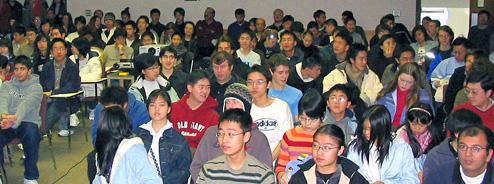
On the morning of Saturday, January 12, 2008, 56 high school students and a dozen adults gathered in the TRIUMF auditorium to peer into the future of particle physics and to consider the nature of science in general.
As part of the Saturday Morning Lecture Series sponsored by TRIUMF and the UBC’s Department of Physics and Astronomy, TRIUMF Director Nigel Lockyer discussed the Holy Grail of particle physics, the Higgs boson. An hour later, TRIUMF Theory Group Leader Byron Jennings challenged the audience to think about how we know what we know and what we mean when we call something “scientific.” Students furiously scribbled notes during each lecture and bombarded the speakers with questions after they were done.
Dr. Nigel Lockyer discussed the “reductionist goals” of particle physics and used powerful metaphors to describe the quest of modern particle physics to discover and study the Higgs boson. In an elegant demonstration of the “spontaneous symmetry breaking” that scientists speculate gave mass to the particles in the universe, Lockyer suspended a steel nail from a magnet. He then applied a blowtorch to the nail; when the steel became hot enough, the tiny atomic magnets became so energetic that their relative alignment became completely randomized. With a dramatic splash, the nail fell off the magnet and into a bucket of cold water. Dr. Lockyer explained that, at this high-temperature state, the nail’s “magnetic symmetry” had been restored. When the nail cooled, the tiny atomic magnets again became aligned, breaking the no-preferred direction of the high-temperature state. At that point, the nail also created a magnetic field that allowed it to be suspended again from the magnet. By analogy, when the universe expanded and cooled after the Big Bang, the symmetry of the electromagnetic and weak forces was broken, and the Higgs field spontaneously gave mass to the particles.
Dr. Byron Jennings discussed the nature of science and the process by which science progresses. He asked students to predict what would happen when he released a pencil he was holding above the desk. He pointed out that scientists prefer to actually “try it and see.” He then showed students that many things could be dropped from the hand and would fall. He asked them to support a generalization, using scientific induction, that all things would fall when dropped. As the students nodded, he then released a helium-filled balloon. Oops! That one didn’t drop to the floor. Using this analogy, Dr. Jennings talked to students about the limitations of scientific deduction and the importance of prediction—and falsifiability. Or, in his words, “an explanation for observations isn’t very scientifically useful if it doesn’t make predictions that can be tested.” He went on to discuss the role of science in developing higher precision models of phenomena in the world and concluded by describing science as &lduqo;observationally constrained model building.”
For more information on the lecture topics and how to register, visit the Saturday Morning Lecture Series page.
